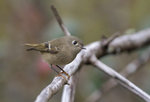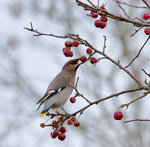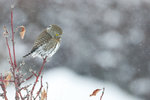


In mid-December, we had several consecutive days of bitter cold, ice and snow. Further north in our Puget Sound area, the weather was even worse. Yet, the birds seemed to survive just fine. How do they manage this?
Not surprisingly, ornithology researchers have wondered about the same thing and have conducted many inquiries over the decades. Some of the answers are deeply insightful and others are a bit more obvious, but birds of all species, especially the smaller ones, manage to survive winter.
The change of seasons presents two huge challenges to bird survival – less food and colder temperatures. Birds have evolved two responses to the coming of winter: either migrate to locations with warmer temperatures and a better food supply or stay locally and tough it out. Either choice has costs and benefits.
Migration is physically challenging and dangerous. Just imagine being a ½ oz. warbler flying alone across the Gulf of Mexico. If you make it, you’re wintering in paradise. In the spring, you have to make the same trip headed north. Staying where you are in the north has the benefit of avoiding the perils of those two long flights and, if you survive, you are likely to be the first on the breeding grounds.
Either way, these warm-blooded neighbors of ours follow the same preparation regime: They stuff themselves with all the calories they can manage to put on extra body fat. Researchers have found that at the end of this fall feeding, birds often weigh 40+% more than during the summer breeding season, and a lot of that is an extra fat layer. But not all.
Our wintering birds undergo other biological changes as well. The feather weight of wintering birds is 30-70% heavier than their summer weight, and this makes up a big portion of the overall weight gain. Birds keep warm in part by wearing two layers – a water-resistant overcoat and an inner down jacket.
Birds have two types of feathers, bristly outer feathers, and puffy inner down feathers. They constantly preen their feathers because well-maintained feathers are critical for winter survival. Most birds have an oil gland at the base of their tails, and they use this oil to weatherproof those outer feathers. The inner down, especially when fluffed up, holds still air that is critical for winter warmth.
Some birds, such as our resident chickadees, also have the ability to “shiver” to stay warm. It’s not the same biologically as our shivering, but it has a similar function. Also, chickadees and other small birds have the ability to go into torpor, slowing down their metabolism, breathing and heartbeat. Thus, they use less energy and have a greater probability of surviving very cold conditions. Hummingbirds, including our resident Anna’s Hummingbird, are renowned for utilizing torpor states to survive.
Finally, many of our smaller winter residents are specialists in finding small cavities and other places to spend the night, including bird boxes. Some birds roost together in the sheltered areas, cuddling together to share warmth. Keeping warm during a long winter’s night burns up fat supplies quickly, so the first assignment each morning is to find food.
Different species have different food targets. When the ground is frozen, for example, robins seek out berries. Holly and some other berries are inedible until they have been frozen. Thus, freezing weather can actually produce a new food source for robins, thrushes and Cedar Waxwings that feast on winter berries.
Some of our smaller winter birds, for example, the Ruby-crowned Kinglet, eat insects. Even in the middle of winter, they search for all sorts of food, be it snail eggs or spiders’ nests (both the eggs and the web are edible). Two winters ago, I found a piece of wood in the garage; its underside was covered with spiders’ nests. I took it outside, leaned it against the garage, and two days later it was entirely clean of all traces of those nests.
Humans can provide a food source too. One of the joys of winter is putting out food for the birds. Especially on very cold days, this can make a huge difference for your local birds. Black oil sunflower seeds are especially good as they have a high fat content. Not all birds will visit your feeder; some are only comfortable feeding on the ground. So, in addition to keeping that bird feeder filled, it’s a good idea to spread some seeds on the ground or pavement. Once they have found your feeder, you can expect a steady stream of early visitors, looking for that first morning bite to eat.
George Walter is environmental program manager at the Nisqually Indian Tribe’s natural resources department; he also has a 40+ year interest in bird watching. He may be reached at george@theJOLTnews.com
Photos for this column are provided by Liam Hutcheson, a 15-year-old Olympia area birder and avid photographer.
1 comment on this item Please log in to comment by clicking here
Johnwils
Thanks for the interesting article! I also like Liam’s and Suerob’s photos. I’ve never heard of nor seen that Pygmy owl. I’ve been making sure I clean and fill my bird feeders and suet feeder, as well as the hummingbird feeders. This last cold snap, I made sure to get up before dawn and put out unfrozen feeders, and replaced them throughout the day if necessary. Last year I used tips from folks that included using socks and the packets of heat that one uses for warming hands to keep the fluid liquid. Keep up the good articles!
Friday, January 6, 2023 Report this